Study on the Effect of Preheating Temperatures on Melt Pool Stability in Inconel 718 Components Processed by Laser Powder Bed Fusion
Abstract
1. Introduction
2. Materials and Methods
- -
- The single tracks analysis is performed through the measurement in five random tracks of the melt pool width and depth;
- -
- The multi-tracks analysis is performed by measuring the overlap depth and width of five random tracks.
3. Results
3.1. Study of Preheating Temperature Effect on 40 Microns Layered Specimens
3.1.1. Single Tracks Analysis
3.1.2. Multi-Tracks Analysis
3.2. Study of Preheating Temperature Effect on 60 Microns Layered Specimens
4. Discussion
4.1. Study of Preheating Temperature Effect on 40 Microns Layered Specimens
4.2. Study of Preheating Temperature Effect on 60 Microns Layered Specimens
5. Conclusions
Author Contributions
Funding
Data Availability Statement
Conflicts of Interest
References
- Wang, Z.; Guan, K.; Gao, M.; Li, X.; Chen, X.; Zeng, X. The microstructure and mechanical properties of deposited-IN718 by selective laser melting. J. Alloys Compd. 2012, 513, 518–523. [Google Scholar] [CrossRef]
- Das, S. Physical aspects of process control in selective laser sintering of metals. Adv. Eng. Mater. 2003, 5, 701–711. [Google Scholar] [CrossRef]
- Osakada, K.; Shiomi, M. Flexible manufacturing of metallic products by selective laser melting of powder. Int. J. Mach. Tools Manuf. 2006, 46, 1188–1193. [Google Scholar] [CrossRef]
- Kruth, J.P.; Mercelis, P.; Van Vaerenbergh, J.; Froyen, L.; Rombouts, M. Binding mechanisms in selective laser sintering and selective laser melting. Rapid Prototyp. J. 2005, 11, 26–36. [Google Scholar] [CrossRef]
- Yadroitsev, I.; Gusarov, A.; Yadroitsava, I.; Smurov, I. Single track formation in selective laser melting of metal powders. J. Mater. Process. Technol. 2010, 210, 1624–1631. [Google Scholar] [CrossRef]
- Gu, D.D.; Meiners, W.; Wissenbach, K.; Poprawe, R. Laser additive manufacturing of ceramic components: Materials, processes, and mechanisms. Laser Addit. Manuf. Mater. Des. Technol. Appl. 2016, 6608, 163–180. [Google Scholar]
- Smith, J.; Xiong, W.; Yan, W.; Lin, S.; Cheng, P.; Kafka, O.L.; Wagner, G.J.; Cao, J.; Liu, W.K. Linking process, structure, property, and performance for metal-based additive manufacturing: Computational approaches with experimental support. Comput. Mech. 2016, 57, 583–610. [Google Scholar] [CrossRef]
- Metelkova, J.; Kinds, Y.; Kempen, K.; De Formanoir, C.; Witvrouw, A.; Van Hooreweder, B. On the influence of laser defocusing in Selective Laser Melting of 316L. Addit. Manuf. 2018, 23, 161–169. [Google Scholar] [CrossRef]
- Ceccanti, F.; Giorgetti, A.; Arcidiacono, G.; Citti, P. Laser Powder Bed Fusion: A Review on the Design Constraints. IOP Conf. Ser. Mater. Sci. Eng. 2021, 1038, 012065. [Google Scholar] [CrossRef]
- Singh, S.N.; Chowdhury, S.; Nirsanametla, Y.; Deepati, A.K.; Prakash, C.; Singh, S.; Wu, L.Y.; Zheng, H.Y.; Pruncu, C. A Comparative Analysis of Laser Additive Manufacturing of High Layer Thickness Pure Ti and Inconel 718 Alloy Materials Using Finite Element Method. Materials 2021, 14, 876. [Google Scholar] [CrossRef] [PubMed]
- Yadroitsev, I.; Yadroitsava, I. A step-by-step guide to the L-PBF process. In Fundamentals of Laser Powder Bed Fusion of Metals; Elsevier: Amsterdam, The Netherlands, 2021. [Google Scholar]
- Ciappi, A.; Giorgetti, A.; Ceccanti, F.; Canegallo, G. Technological and economical consideration for turbine blade tip restoration through metal deposition technologies. Proc. Inst. Mech. Eng. Part C J. Mech. Eng. Sci. 2021, 235, 1741–1758. [Google Scholar] [CrossRef]
- Cobbinah, P.V.; Nzeukou, R.A.; Onawale, O.T.; Matizamhuka, W.R. Laser Powder Bed Fusion of Potential Superalloys: A Review. Metals 2021, 11, 58. [Google Scholar] [CrossRef]
- Abd-Elaziem, W.; Elkatatny, S.; Abd-Elaziem, A.; Khedr, M.; El-baky, M.A.A.; Hassan, M.A.; Abu-Okail, M.; Mohammed, M.; Järvenpää, A.; Allam, T.; et al. On the current research progress of metallic materials fabricated by laser powder bed fusion process: A review. J. Mater. Res. Technol. 2022, 20, 681–707. [Google Scholar] [CrossRef]
- Ceccanti, F.; Giorgetti, A.; Citti, P. A support structure design strategy for laser powder bed fused parts. Procedia Struct. Integr. 2019, 24, 667–679. [Google Scholar] [CrossRef]
- Khan, H.M.; Karabulut, Y.; Kitay, O.; Kaynak, Y.; Jawahir, I.S. Influence of the post-processing operations on surface integrity of metal components produced by laser powder bed fusion additive manufacturing: A review. Mach. Sci. Technol. 2021, 25, 118–176. [Google Scholar] [CrossRef]
- Mostafaei, A.; Zhao, C.; He, Y.; Ghiaasiaan, S.R.; Shi, B.; Shao, S.; Shamsaei, N.; Wu, Z.; Kouraytem, N.; Sun, T.; et al. Defects and anomalies in powder bed fusion metal additive manufacturing. Curr. Opin. Solid State Mater. Sci. 2022, 26, 100974. [Google Scholar] [CrossRef]
- Makona, N.W.; Yadroitsava, I.; Moller, H.; Tlotleng, M.; Yadroitsev, I. Evaluation of single tracks of 17-4PH steel manufactured at different power densities and scanning speeds by selective laser melting. S. Afr. J. Ind. Eng. 2016, 27, 210–218. [Google Scholar] [CrossRef][Green Version]
- Liu, X.; Wang, K.; Hu, P.; He, X.; Yan, B.; Zhao, X. Formability, Microstructure and Properties of Inconel 718 Superalloy Fabricated by Selective Laser Melting Additive Manufacture Technology. Materials 2021, 14, 991. [Google Scholar] [CrossRef] [PubMed]
- Blakey-Milner, B.; Gradl, P.; Snedden, G.; Brooks, M.; Pitot, J.; Lopez, E.; Leary, M.; Berto, F.; Du Plessis, A. Metal additive manufacturing in aerospace: A review. Mater. Des. 2021, 209, 110008. [Google Scholar] [CrossRef]
- Bidulsky, R.; Gobber, F.S.; Bidulska, J.; Ceroni, M.; Kvackaj, T.; Grande, M.A. Coated Metal Powders for Laser Powder Bed Fusion (L-PBF) Processing: A Review. Metals 2021, 11, 1831. [Google Scholar] [CrossRef]
- Mahmoud, D.; Magolon, M.; Boer, J.; Elbestawi, M.A.; Mohammadi, M.G. Applications of Machine Learning in Process Monitoring and Controls of L-PBF Additive Manufacturing: A Review. Appl. Sci. 2021, 21, 11910. [Google Scholar] [CrossRef]
- Chen, Q.; Zhao, Y.; Strayer, S.; Zhao, Y.; Aoyagi, K.; Koizumi, Y.; Chiba, A.; Xiong, W.; To, A.C. Elucidating the effect of preheating temperature on melt pool morphology variation in Inconel 718 laser powder bed fusion via simulation and experiment. Addit. Manuf. 2021, 37, 101642. [Google Scholar] [CrossRef]
- Panahi, N.; Åsberg, M.; Oikonomou, C.; Krakhmalev, P. Effect of preheating temperature on the porosity and microstructure of martensitic hot work tool steel manufactured with L-PBF. Procedia CIRP 2022, 111, 166–170. [Google Scholar] [CrossRef]
- Polozov, I.; Sufiiarov, V.; Kantyukov, A.; Razumov, N.; Goncharov, I.; Makhmutov, T.; Silin, A.; Kim, A.; Starikov, K.; Shamshurin, A. Microstructure, densification, and mechanical properties of titanium intermetallic alloy manufactured by laser powder bed fusion additive manufacturing with high-temperature preheating using gas atomized and mechanically alloyed plasma spheroidized powders. Addit. Manuf. 2020, 34, 101374. [Google Scholar] [CrossRef]
- Ahmadi, M.; Tabary, S.B.; Rahmatabadi, D.; Ebrahimi, M.S.; Abrinia, K.; Hashemi, R. Review of Selective Laser Melting of Magnesium Alloys: Advantages, Microstructure and Mechanical Characterizations, Defects, Challenges, and Applications. J. Mater. Res. Technol. 2022, 19, 1537–1562. [Google Scholar] [CrossRef]
- Li, S.; Xiao, H.; Liu, K.; Xiao, W.; Li, Y.; Han, X.; Song, J.M.L. Melt-pool motion, temperature variation and dendritic morphology of Inconel 718 during pulsed- and continuous-wave laser additive manufacturing: A comparative study. Mater. Des. 2017, 119, 351–360. [Google Scholar] [CrossRef]
- Childs, T.H.C.; Hauser, C.; Badrossamay, M. Mapping and Modelling Single Scan Track Formation in Direct Metal Selective Laser Melting. CIRP Ann. 2004, 53, 191–194. [Google Scholar] [CrossRef]
- Guo, Y.; Jia, L.; Kong, B.; Wang, N.; Zhang, H. Single track and single layer formation in selective laser melting of niobium solid solution alloy. Chin. J. Aeronaut. 2018, 31, 860–866. [Google Scholar] [CrossRef]
- Shrestha, S.; Chou, K. Single track scanning experiment in laser powder bed fusion process. Procedia Manuf. 2018, 26, 857–864. [Google Scholar] [CrossRef]
- Yadroitsava, I.; Els, J.; Booysen, G.; Yadroitsev, I. Peculiarities of single track formation from Ti6AL4V alloy at different laser power densities by selective laser melting. S. Afr. J. Ind. Eng. 2015, 26, 86–95. [Google Scholar] [CrossRef]
- Zheng, H.; Wang, Y.; Xie, Y.; Yang, S.; Hou, R.; Ge, Y.; Lang, L.; Gong, S.; Li, H. Observation of Vapor Plume Behavior and Process Stability at Single-Track and Multi-Track Levels in Laser Powder Bed Fusion Regime. Metals 2021, 11, 937. [Google Scholar] [CrossRef]
- Johnson, L.; Mahmoudi, M.; Zhang, B.; Seede, R.; Huang, X.; Maier, J.T.; Maier, H.J.; Karaman, I.; Elwany, A.; Arróyave, R. Assessing printability maps in additive manufacturing of metal alloys. Acta Mater. 2019, 176, 199–210. [Google Scholar] [CrossRef]
- Tenbrock, C.; Fischer, F.G.; Wissenbach, K.; Schleifenbaum, J.H.; Wagenblast, P.; Meiners, W.; Wagner, J. Influence of keyhole and conduction mode melting for top-hat shaped beam profiles in laser powder bed fusion. J. Mater. Process. Technol. 2020, 278, 116514. [Google Scholar] [CrossRef]
- King, W.A.; Barth, H.D.; Castillo, V.M.; Gallegos, G.F.; Gibbs, J.W.; Hahn, D.E.; Kamath, C.; Rubenchik, A.M. Observation of keyhole-mode laser melting in laser powder-bed fusion additive manufacturing. J. Mater. Process. Technol. 2014, 214, 2915–2925. [Google Scholar] [CrossRef]
- Tian, Y.; Tomus, D.; Rometsch, P.; Wu, X. Influences of processing parameters on surface roughness of Hastelloy X produced by selective laser melting. Addit. Manuf. 2017, 13, 103–112. [Google Scholar] [CrossRef]
- Ning, J.; Wang, W.; Zamorano, B.; Liang, S.Y. Analytical modeling of lack-of-fusion porosity in metal additive manufacturing. Appl. Phys. 2019, 125, 797. [Google Scholar] [CrossRef]
- Mukherjee, T.; DebRoy, T. Mitigation of lack of fusion defects in powder bed fusion additive manufacturing. J. Manuf. Process. 2018, 36, 442–449. [Google Scholar] [CrossRef]
- Giorgetti, A.; Baldi, N.; Palladino, M.; Ceccanti, F.; Arcidiacono, G.; Citti, P. A Method to Optimize Parameters Development in L-PBF Based on Single and Multitracks Analysis: A Case Study on Inconel 718 Alloy. Metals 2023, 13, 306. [Google Scholar] [CrossRef]
- Baldi, N.; Giorgetti, A.; Palladino, M.; Giovannetti, I.; Arcidiacono, G.; Citti, P. Study on the Effect of Inter-Layer Cooling Time on Porosity and Melt Pool in Inconel 718 Components Processed by Laser Powder Bed Fusion. Materials 2023, 16, 3920. [Google Scholar] [CrossRef] [PubMed]
- Altin, A.; Nalbant, M.; Taskesen, A. The effects of cutting speed on tool wear and tool life when machining Inconel 718 with ceramic tools. Mater. Des. 2007, 28, 2518–2522. [Google Scholar] [CrossRef]
- Watring, D.S.; Carter, K.C.; Crouse, D.; Raeymaekers, B.; Spear, A.D. Mechanisms driving high-cycle fatigue life of as-built Inconel 718 processed by laser powder bed fusion. Mater. Sci. Eng. A 2019, 761, 137993. [Google Scholar] [CrossRef]
- Balbaa, M.; Mekhiel, S.; Elbestawi, M.; McIsaac, J. On Selective laser melting of Inconel 718: Densification, surface roughness, and residual stresses. Mater. Des. 2020, 193, 108818. [Google Scholar] [CrossRef]
- ASTM E407-07; Standard Practice for Microetching Metals and Alloys. ASTM International: West Conshohocken, PA, USA, 2015; p. e1.
- ASTM E3-11; Standard Guide for Preparation of Metallographic Specimens. ASTM International: West Conshohocken, PA, USA, 2017.
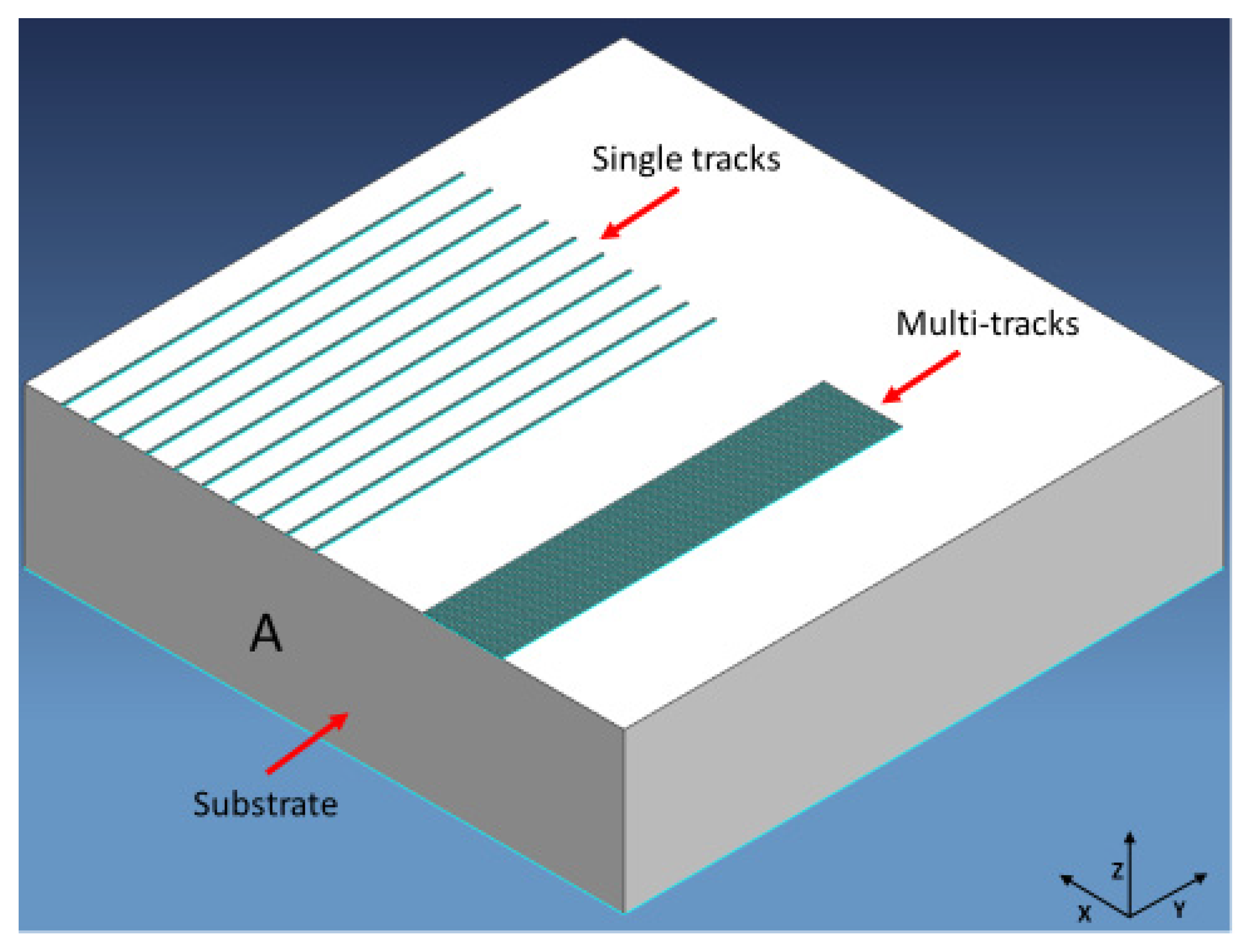


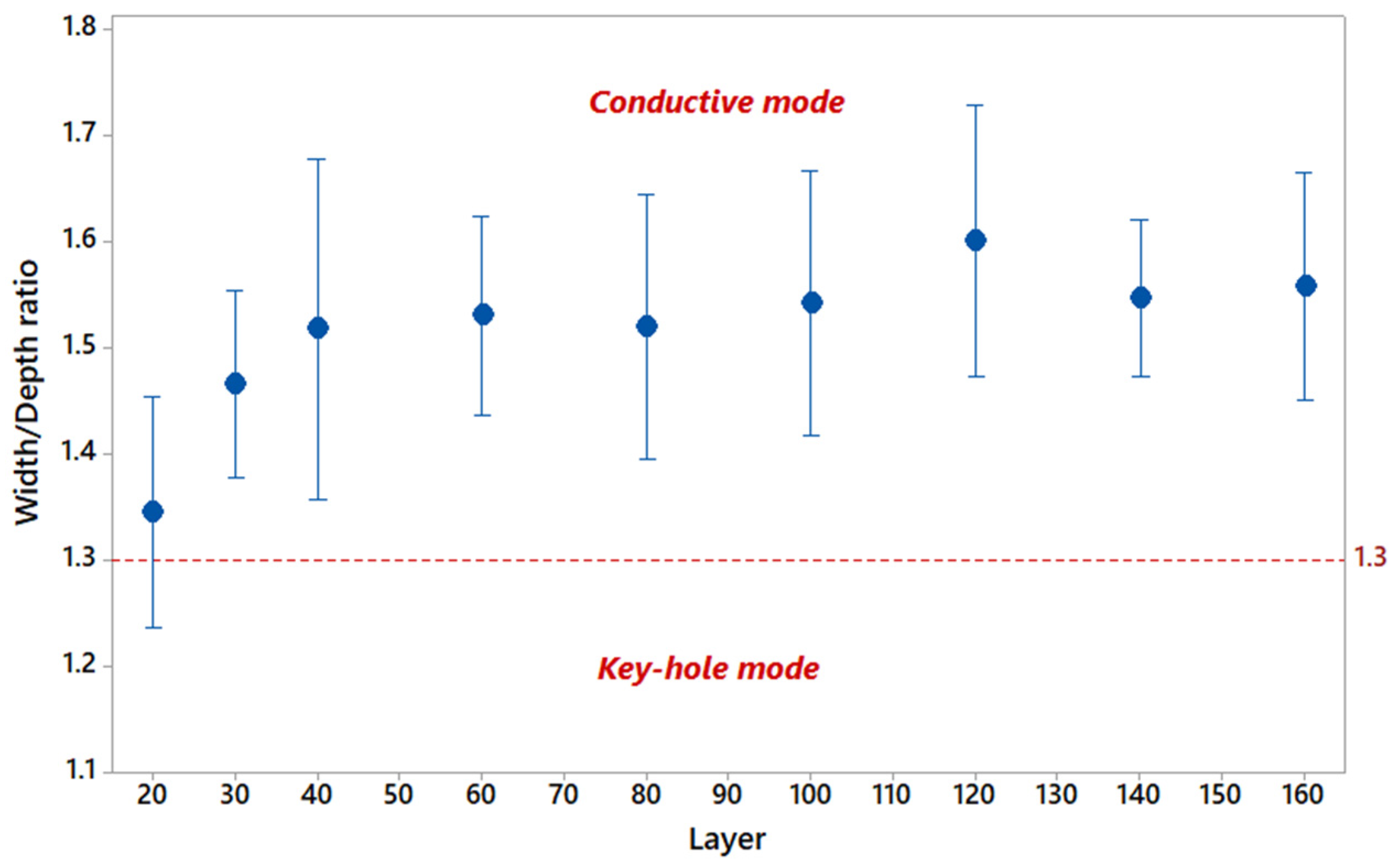
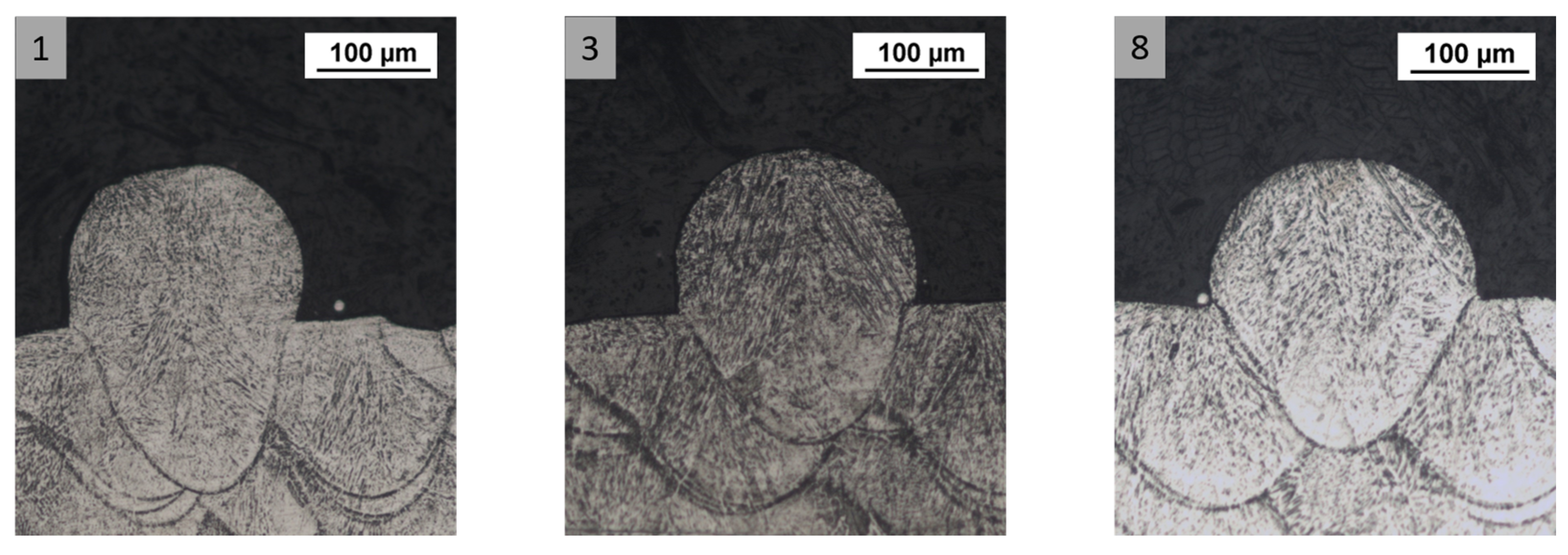

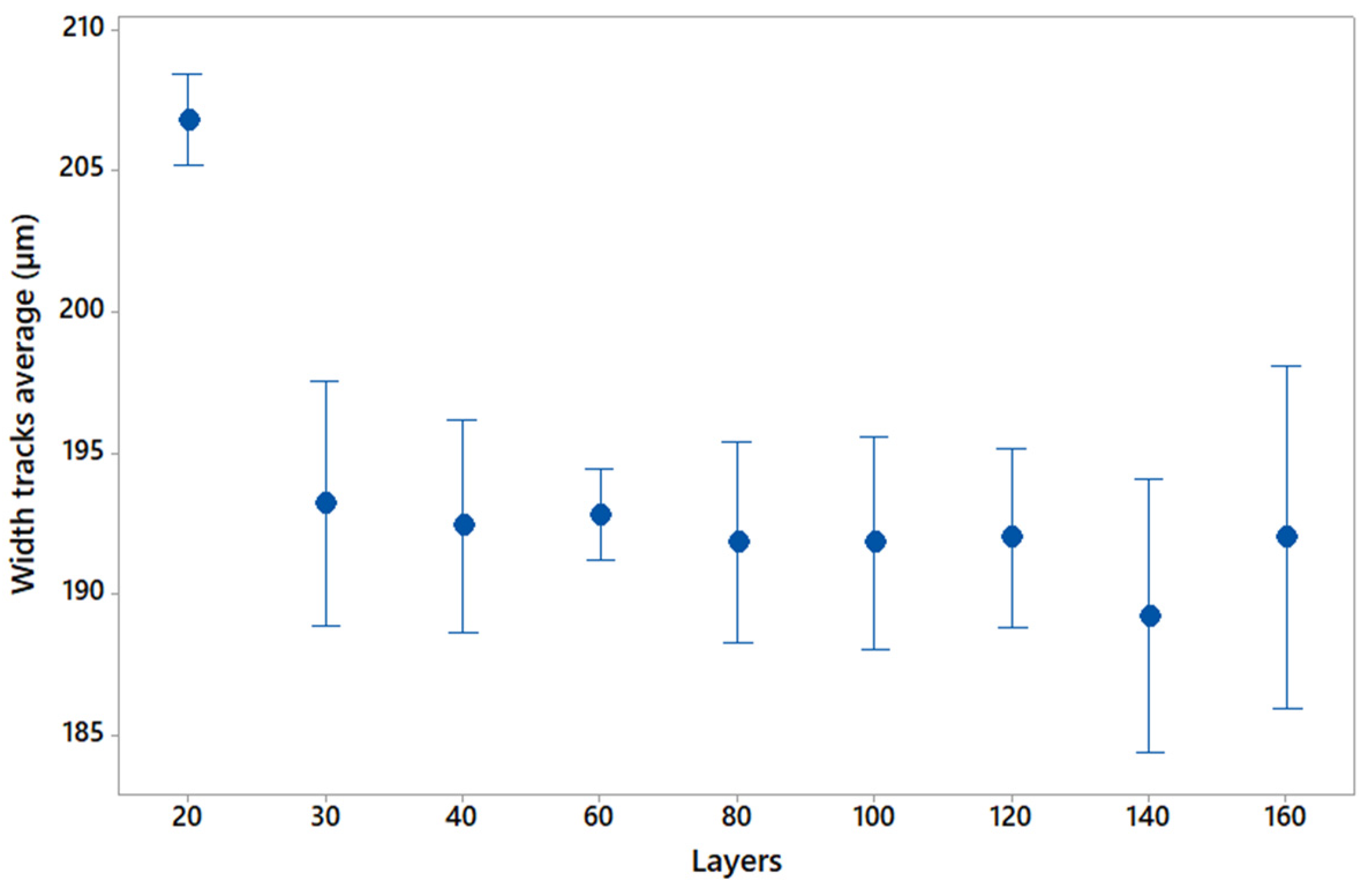


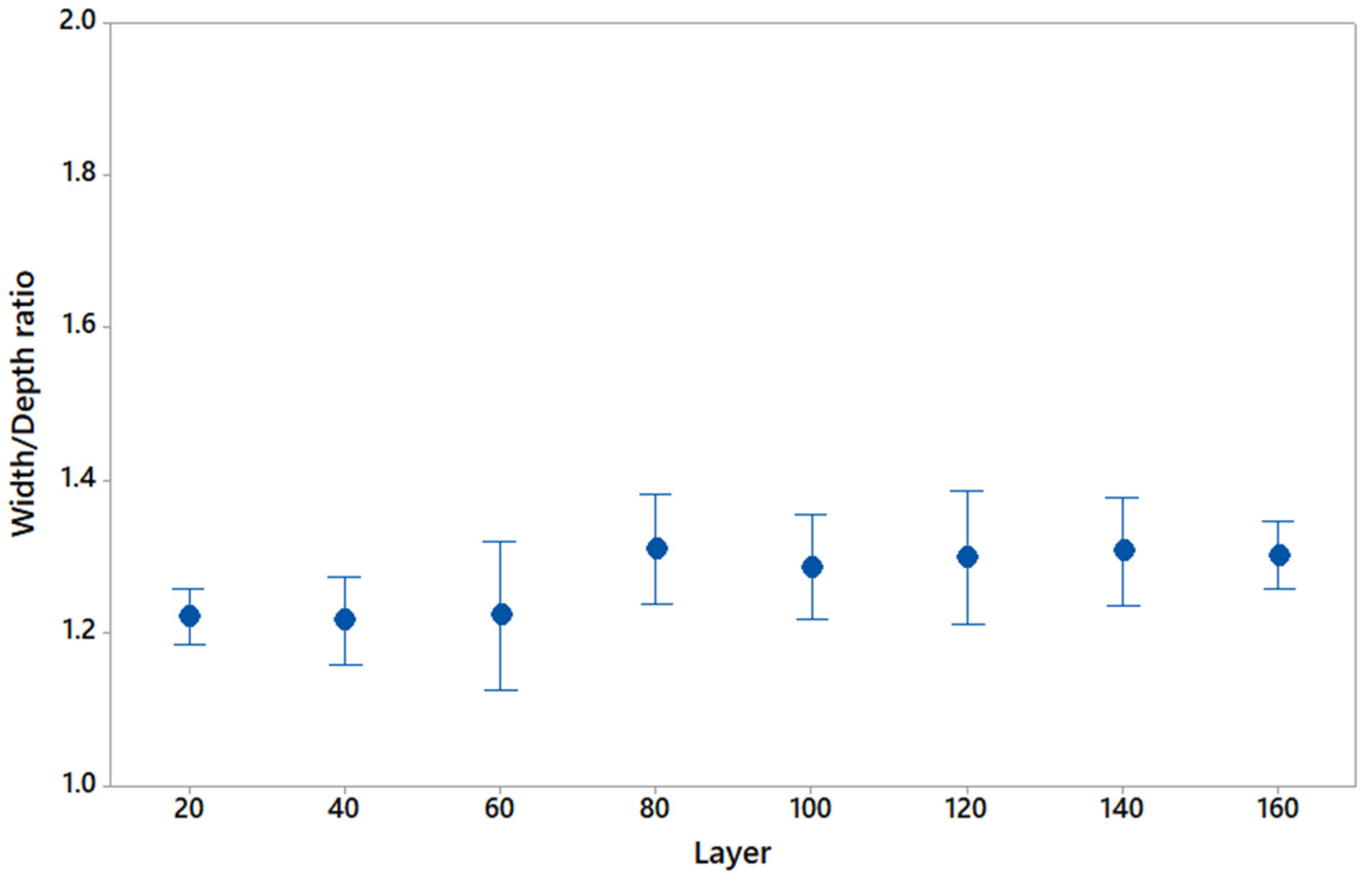




| Element | % Weight |
|---|---|
| Ni | 55.37 |
| Cr | 18.37 |
| Ni | 55.37 |
| Mn | 0.08 |
| Si | 0.08 |
| P | <0.015 |
| S | 0.002 |
| C | 0.040 |
| Nb | 5.33 |
| Co | 0.23 |
| Mo | 3.04 |
| Nb + Ta | 5.34 |
| Ti | 0.98 |
| Al | 0.5 |
| B | 0.004 |
| Fe | 17.80 |
| Ta | 0.005 |
| Cu | 0.04 |
| Ca | <0.01 |
| Mg | <0.01 |
| Pb | 0.0001 |
| Bi | 0.0001 |
| Se | <0.001 |
| Yield Strength (Mpa) | Tensile Stress (Mpa) | Elastic Modulus (Gpa) | Strain (%) | Thermal Conductivity (W/mK) | Density (kg/m3) |
|---|---|---|---|---|---|
| 1100 | 1310 | 206 | 23.3 | 11.2 | 8470 |
| Layer Thickness (μm) | Laser Power (W) | Scanning Speed (mm/s) | Hatch Distance (mm) |
|---|---|---|---|
| 40 | 270 | 960 | 0.11 |
| 60 | 355 | 960 | 0.11 |
| Configuration | Substrate Height (Layers) | Layer Thickness (μm) |
|---|---|---|
| 1 | 20 | 40 |
| 2 | 30 | 40 |
| 3 | 40 | 40 |
| 4 | 60 | 40 |
| 5 | 80 | 40 |
| 6 | 100 | 40 |
| 7 | 120 | 40 |
| 8 | 140 | 40 |
| 9 | 160 | 40 |
| 10 | 20 | 60 |
| 11 | 40 | 60 |
| 12 | 60 | 60 |
| 13 | 80 | 60 |
| 14 | 100 | 60 |
| 15 | 120 | 60 |
| 16 | 140 | 60 |
| 17 | 160 | 60 |
| Configurations | Depth (µm) | Width (µm) | Width/Depth | Depth/Thickness | ||||
|---|---|---|---|---|---|---|---|---|
| Avg. | SD | Avg. | SD | Avg. | SD | Avg. | SD. | |
| 1 | 120.2 | 6.27 | 175.6 | 3.58 | 1.35 | 0.09 | 3.0 | 0.16 |
| 2 | 107.6 | 4.45 | 157.8 | 3.11 | 1.46 | 0.07 | 2.7 | 0.11 |
| 3 | 104.2 | 6.18 | 153.0 | 5.24 | 1.52 | 0.13 | 2.6 | 0.15 |
| 4 | 104.8 | 4.65 | 155.2 | 3.27 | 1.53 | 0.07 | 2.6 | 0.12 |
| 5 | 102.0 | 7.38 | 154.4 | 4.28 | 1.50 | 0.10 | 2.6 | 0.18 |
| 6 | 102.2 | 6.14 | 157.0 | 2.55 | 1.50 | 0.10 | 2.6 | 0.15 |
| 7 | 101.0 | 5.00 | 161.2 | 3.63 | 1.60 | 0.10 | 2.5 | 0.13 |
| 8 | 102.0 | 6.04 | 157.4 | 5.03 | 1.50 | 0.06 | 2.6 | 0.15 |
| 9 | 103.0 | 5.00 | 160.0 | 2.45 | 1.60 | 0.09 | 2.6 | 0.13 |
| Configurations | Overlap Depth (µm) | Overlap Width (µm) | Tracks Width (µm) | |||
|---|---|---|---|---|---|---|
| Avg. | SD | Avg. | SD. | Avg. | SD | |
| 1 | 1.35 | 0.09 | 3.0 | 0.16 | 206.8 | 1.30 |
| 2 | 1.46 | 0.07 | 2.7 | 0.11 | 193.2 | 3.49 |
| 3 | 1.52 | 0.13 | 2.6 | 0.15 | 192.4 | 3.05 |
| 4 | 1.53 | 0.07 | 2.6 | 0.12 | 192.8 | 1.30 |
| 5 | 1.50 | 0.10 | 2.6 | 0.18 | 191.8 | 2.86 |
| 6 | 1.50 | 0.10 | 2.6 | 0.15 | 191.8 | 3.03 |
| 7 | 1.60 | 0.10 | 2.5 | 0.13 | 192.0 | 2.55 |
| 8 | 1.50 | 0.06 | 2.6 | 0.15 | 189.2 | 3.89 |
| 9 | 1.60 | 0.09 | 2.6 | 0.13 | 192.0 | 4.90 |
| Configurations | Depth (µm) | Width (µm) | Width/Depth | Depth/Thickness | ||||
|---|---|---|---|---|---|---|---|---|
| Avg. | SD | Avg. | SD | Avg. | SD | Avg. | SD. | |
| 10 | 123.2 | 2.59 | 150.4 | 1.67 | 1.22 | 0.03 | 2.05 | 0.04 |
| 11 | 124.8 | 4.15 | 151.6 | 2.97 | 1.22 | 0.05 | 2.08 | 0.07 |
| 12 | 126.6 | 8.11 | 154.4 | 5.18 | 1.22 | 0.08 | 2.11 | 0.13 |
| 13 | 123.8 | 3.49 | 162.0 | 3.67 | 1.31 | 0.06 | 2.06 | 0.06 |
| 14 | 121.2 | 3.70 | 155.8 | 4.87 | 1.29 | 0.06 | 2.02 | 0.06 |
| 15 | 120.0 | 3.08 | 155.6 | 7.16 | 1.30 | 0.07 | 2.00 | 0.05 |
| 16 | 122.0 | 5.61 | 159.2 | 5.26 | 1.31 | 0.06 | 2.03 | 0.09 |
| 17 | 121.2 | 4.97 | 157.6 | 2.88 | 1.30 | 0.04 | 2.02 | 0.08 |
| Configurations | Overlap Depth (µm) | Overlap Width (µm) | Tracks Width (µm) | |||
|---|---|---|---|---|---|---|
| Avg. | SD | Avg. | SD. | Avg. | SD | |
| 10 | 249.2 | 5.80 | 126.0 | 13.58 | 219.4 | 8.91 |
| 11 | 237.6 | 8.96 | 120.6 | 4.33 | 218.0 | 5.70 |
| 12 | 236.6 | 6.69 | 120.6 | 1.52 | 213.8 | 8.29 |
| 13 | 235.2 | 5.59 | 119.4 | 2.07 | 217.4 | 7.70 |
| 14 | 235.4 | 8.62 | 119.6 | 4.77 | 220.2 | 6.87 |
| 15 | 235.2 | 9.88 | 118.0 | 4.58 | 216.6 | 6.02 |
| 16 | 233.8 | 8.35 | 115.6 | 5.81 | 216.2 | 5.68 |
| 17 | 233.2 | 7.69 | 117.9 | 5.40 | 214.8 | 6.68 |
Disclaimer/Publisher’s Note: The statements, opinions and data contained in all publications are solely those of the individual author(s) and contributor(s) and not of MDPI and/or the editor(s). MDPI and/or the editor(s) disclaim responsibility for any injury to people or property resulting from any ideas, methods, instructions or products referred to in the content. |
© 2023 by the authors. Licensee MDPI, Basel, Switzerland. This article is an open access article distributed under the terms and conditions of the Creative Commons Attribution (CC BY) license (https://creativecommons.org/licenses/by/4.0/).
Share and Cite
Baldi, N.; Giorgetti, A.; Palladino, M.; Giovannetti, I.; Arcidiacono, G.; Citti, P. Study on the Effect of Preheating Temperatures on Melt Pool Stability in Inconel 718 Components Processed by Laser Powder Bed Fusion. Metals 2023, 13, 1792. https://doi.org/10.3390/met13101792
Baldi N, Giorgetti A, Palladino M, Giovannetti I, Arcidiacono G, Citti P. Study on the Effect of Preheating Temperatures on Melt Pool Stability in Inconel 718 Components Processed by Laser Powder Bed Fusion. Metals. 2023; 13(10):1792. https://doi.org/10.3390/met13101792
Chicago/Turabian StyleBaldi, Niccolò, Alessandro Giorgetti, Marco Palladino, Iacopo Giovannetti, Gabriele Arcidiacono, and Paolo Citti. 2023. "Study on the Effect of Preheating Temperatures on Melt Pool Stability in Inconel 718 Components Processed by Laser Powder Bed Fusion" Metals 13, no. 10: 1792. https://doi.org/10.3390/met13101792
APA StyleBaldi, N., Giorgetti, A., Palladino, M., Giovannetti, I., Arcidiacono, G., & Citti, P. (2023). Study on the Effect of Preheating Temperatures on Melt Pool Stability in Inconel 718 Components Processed by Laser Powder Bed Fusion. Metals, 13(10), 1792. https://doi.org/10.3390/met13101792









